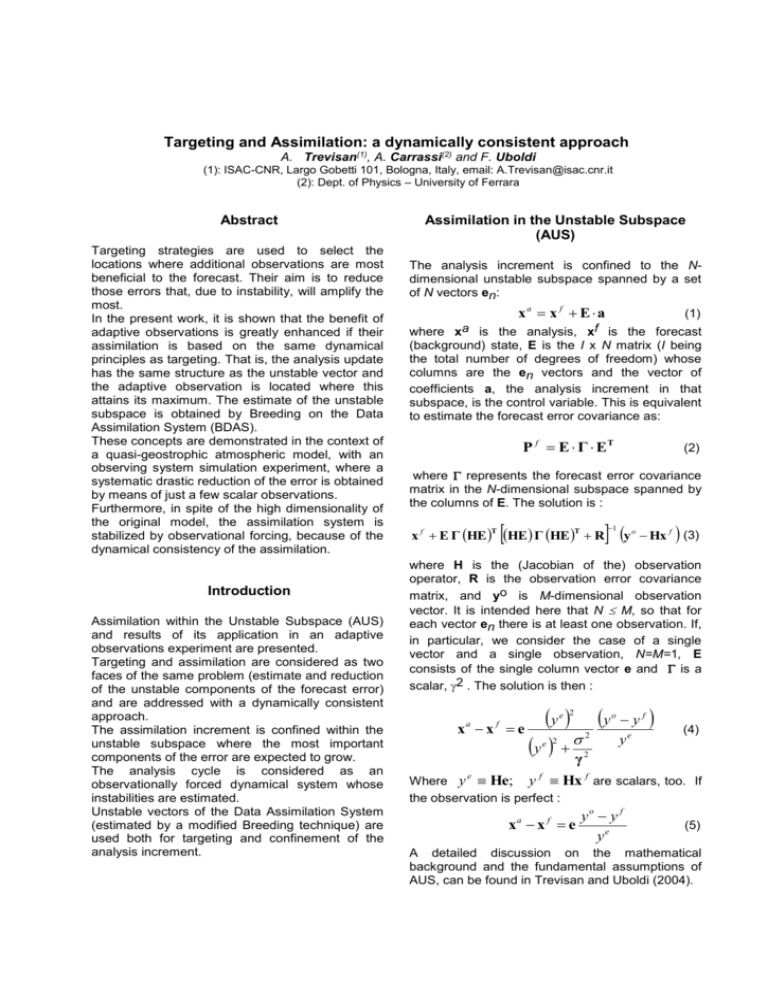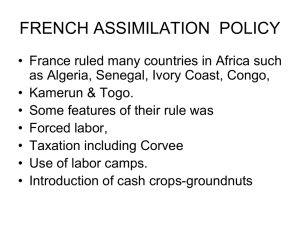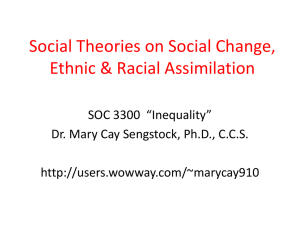Abstract
advertisement

Targeting and Assimilation: a dynamically consistent approach A. Trevisan(1), A. Carrassi(2) and F. Uboldi (1): ISAC-CNR, Largo Gobetti 101, Bologna, Italy, email: A.Trevisan@isac.cnr.it (2): Dept. of Physics – University of Ferrara Abstract Targeting strategies are used to select the locations where additional observations are most beneficial to the forecast. Their aim is to reduce those errors that, due to instability, will amplify the most. In the present work, it is shown that the benefit of adaptive observations is greatly enhanced if their assimilation is based on the same dynamical principles as targeting. That is, the analysis update has the same structure as the unstable vector and the adaptive observation is located where this attains its maximum. The estimate of the unstable subspace is obtained by Breeding on the Data Assimilation System (BDAS). These concepts are demonstrated in the context of a quasi-geostrophic atmospheric model, with an observing system simulation experiment, where a systematic drastic reduction of the error is obtained by means of just a few scalar observations. Furthermore, in spite of the high dimensionality of the original model, the assimilation system is stabilized by observational forcing, because of the dynamical consistency of the assimilation. Introduction Assimilation within the Unstable Subspace (AUS) and results of its application in an adaptive observations experiment are presented. Targeting and assimilation are considered as two faces of the same problem (estimate and reduction of the unstable components of the forecast error) and are addressed with a dynamically consistent approach. The assimilation increment is confined within the unstable subspace where the most important components of the error are expected to grow. The analysis cycle is considered as an observationally forced dynamical system whose instabilities are estimated. Unstable vectors of the Data Assimilation System (estimated by a modified Breeding technique) are used both for targeting and confinement of the analysis increment. Assimilation in the Unstable Subspace (AUS) The analysis increment is confined to the Ndimensional unstable subspace spanned by a set of N vectors en: xa x f E a (1) a f where x is the analysis, x is the forecast (background) state, E is the I x N matrix (I being the total number of degrees of freedom) whose columns are the en vectors and the vector of coefficients a, the analysis increment in that subspace, is the control variable. This is equivalent to estimate the forecast error covariance as: P f E Γ ET (2) where represents the forecast error covariance matrix in the N-dimensional subspace spanned by the columns of E. The solution is : x f E Γ HE T HE Γ HE T R y 1 o Hx f (3) where H is the (Jacobian of the) observation operator, R is the observation error covariance matrix, and yo is M-dimensional observation vector. It is intended here that N M, so that for each vector en there is at least one observation. If, in particular, we consider the case of a single vector and a single observation, N=M=1, E consists of the single column vector e and is a scalar, 2 . The solution is then : x x a y y e y γ e 2 f e 2 2 o yf ye (4) 2 Where y He; y Hx are scalars, too. If the observation is perfect : e f xa x f e f yo y f ye (5) A detailed discussion on the mathematical background and the fundamental assumptions of AUS, can be found in Trevisan and Uboldi (2004). Estimate of the unstable subspace The estimate of the unstable vectors, columns of E, are estimated by a modified form of breeding (Toth and Kalnay, 1997). Since our aim is to estimate the instabilities of the complete analysisforecast cycle solution, we let the perturbed trajectories undergo the same observational forcing as the control trajectory. What is called breeding on the data assimilation system (BDAS) is similar to the standard breeding technique, the main difference being the application of the analysis step to the perturbed trajectories (Carrassi et al. 2005). Experiments In the following, the main steps for the implementation of AUS in targeting and assimilation experiments are summarized: Estimate of the unstable subspace is obtained by BDAS; Targeted observations are placed at locations where bred vectors en have maximum component; A wide (2500km) Gaussian modulating function is used to isolate the regional structure of the bred vectors; A small number N of Bred Vectors are used to construct the matrix E; Use E in (3) to perform the analysis; Experiments are performed using a quasigeostrophic periodic channel model (Rotunno and Bao, 1996) with 64-longitudinal and 32-latitudinal grid points and 5 vertical levels where potential vorticity is specified. The perfect model assumption is made. A fixed observational network, consisting of vertical sounding, completely covers the western-most third of the domain (land, longitudinal grid points 1-20). All land observations are assimilated by means of a 3DVAR algorithm (Morss et al., 1999). The rest of the domain (ocean) is completely void of observations except for a single observation adaptively located at each analysis step. We compare results of two different sets of experiments: Experiment type I: all observations, fixed and adaptive, are assimilated by means of 3DVAR Experiment type II: the fixed observations are assimilated by means of 3DVAR; the adaptive observations by means of AUS In experiments type I the adaptive observation consists of a complete vertical sounding measuring temperature and the horizontal velocity components. On the other hand, in experiments type II the adaptive observation consists of a single temperature observation. We point out that in both sets of experiments the adaptive observation is placed where the current bred vector attains its maximum amplitude. In all experiments a single bred vector is used at each analysis step. The breeding time has been set to 10 days after optimization (Carrassi, 2005). After being used for targeting (and assimilation in experiments type II) the bred vector is discarded and a new perturbation is introduced. Results All results presented here are obtained years long simulated assimilation Experiments are performed using both (labeled by P) and noisy (labeled observations. with 2 cycles. perfect by N) - Perfect Observations Fig. 1 shows the normalized (with respect to natural variability) RMS analysis error as a function of time. The dotted line refers to exp. I-P (where the adaptive vertical sounding is assimilated by 3DVAR) while the continuous one refers to exp. IIP that uses (5) to assimilate the adaptive temperature observation over the ocean. FIG (1): Normalized RMS analysis error as a function of time. The error is expressed in potential enstrophy norm and it is normalized by natural variability. Dotted line: I-P; Continuous Line: II-P After about 60 days the average analysis error of exp. II-P (continuous line) drops below 10% of natural variability and it never exceeds it afterwards. The improvement with respect to the 3DVAR experiment is evident. Table 1 contains the space and time average error from the following experiments: an experiment with only fixed land observations assimilated by 3DVAR (Land-Obs), an experiment where the location of the adaptive vertical sounding is randomly chosen (RandomObs) and experiments I-P and II-P. Experiment RMS Analysis Error Land-Obs Random-Obs I-P II-P 0.43 0.38 0.35 0.02 TABLE 1: Space and time (after 150 days transient) average analysis error, normalized by natural variability, for the indicated experiments. As could be anticipated, the introduction of the randomly located observation, over the large data void area, leads to an improvement that is however more significant when it is located using BDAS (IP). This proves that BDAS is efficient in capturing the real system instabilities. Finally the largest improvement is obtained when the ocean observation is located by BDAS and assimilated by AUS (II-P). dimension 21). This demonstrates that, with respect to 3DVAR, AUS better exploits a smaller amount of information. The upper and middle panels of fig. 2 show the normalized time and vertical average RMS analysis error for experiments I-P and II-P respectively. In both cases an initial transient of 150 days has been omitted when calculating the mean. The analysis error domain distribution reflects the particular observational network: larger error values are found in the data void region (longitudinal grid points 21-64) and an eastward error advection influences the land area. Anyhow, apart from these common features, the most relevant difference between I-P and II-P is the order of magnitude of errors; as already evident from fig. 1 in I-P the error is strongly reduced with respect to II-P. The curves in the lower panel represent the RMS analysis error as a function of longitude. We see that the error over the ocean using AUS (II-P) is everywhere smaller than the minimum error (over land) using 3DVAR (I-P). - Stability Analysis Data assimilation systems constrain the control trajectory to remain ‘close’ to the true trajectory. The assimilation of observations itself can be naturally seen as a forcing on the model dynamics. Therefore the analysis cycle can be considered as an observationally forced dynamical system whose stability can be studied. The QG model at the present resolution (i.e. the system without the observational forcing) possesses 25 positive Lyapunov exponents. The leading exponent is equal to 0.32 day-1 that implies a doubling time of about 2 days and the KaplanYorke dimension is approximately 69.07. Fig. 3 shows the leading exponent for the data assimilation systems of experiments I-P and II-P. The values are obtained averaging over all previous instants. After about 100 days the exponent relative to II-P reaches negative values and it remains negative afterwards. FIG (2): Upper panel: Normalized time and vertical average RMS analysis error from experiment I-P. Middle panel: Normalized time and vertical average RMS analysis error from experiment II-P. Lower panel: Normalized time vertical and latitudinal average RMS analysis error; continuous line: I-P; dotted line: II-P. It should be reminded here that in II-P the adaptive observation is a single temperature observation (y0 is a scalar) while in all other cases, including II-P it consists of a complete vertical sounding (y0 has FIG (3): Leading Lyapunov exponent of the assimilation systems as a function of time. Dotted line: I-P (3DVar); Continuous Line: II-P (AUS). Values are averaged over all previous instants. The growth rate is expressed in units of days-1. A negative leading Lyapunov exponent indicates that the observational forcing stabilizes the solution. On the other hand the forcing by 3DVAR reduces the leading growth rate of the free system but is unable to stabilize the solution. Fig. 5 is the same as fig. 2 (bottom panel). It shows the normalized latitudinal, vertical and time average RMS analysis error for I-N and II-N. - Noisy Observations Assessment of the value of adaptive observations from field campaign is still underway and the results so far are controversial. The main conclusion of this work is that the benefit of adaptive observations is greatly enhanced if their assimilation is based on the same dynamical principles as targeting. Results show that a few carefully selected and properly assimilated observations are sufficient to control the instabilities of the Data Assimilation System and obtain a drastic reduction of the analysis error. Further results (Uboldi et al., 2005) obtained in the context of a primitive equation ocean model and regular observational network are also very encouraging. The extension to the four dimensional case is in progress. The success obtained so far makes us confident that, even in an operational environment with real observations, this method can yield significant improvement of the assimilation performance. Although the perfect observations case represents an important idealized simplification and allows a first assimilation performance comparison, noisy observations experiments better represent real conditions. Therefore a comparison is made also in this context. We use the same observational configuration of IP and II-P but reduce the assimilation interval from 12 to 6 hr. The assimilation of the isolated ocean observation in II-N is made by applying (4). In this case therefore we need to estimate the coefficient representing the background error projection on the unstable direction e. In the simple case of a single unstable vector at each analysis time, is a scalar coefficient that can be easily estimated on a statistical basis (Carrassi et al., 2005). Fig. 4 is the same as fig. 1 but using noisy observations. Although less spectacular than in the prefect observations case, a drastic reduction of the analysis error is obtained using AUS. Conclusions References Carrassi A., 2005. Geophysical Data Analysis: A new dynamically based assimilation method. PhD thesis, University of Ferrara, Italy, 120 pp. (www.isac.cnr.it/~dinamica/predictability/) Carrassi A., A. Trevisan and F. Uboldi, 2005. Deterministic Data Assimilation and Targeting by Breeding on the Data Assimilation System. In review for J. Atmos. Sci.. FIG (4): Same as fig (1); Dotted line: Experiment I-N; Continuous Line: Experiment II-N Morss R., 1999. Adaptive Observations: Idealized sampling strategy for improving numerical weather prediction. PhD thesis, Massachussets of Technology, Cambridge, MA, 225 pp. Rotunno R., and J. W. Bao, 1996. A case study of cyclogenesis using a model hierarchy. Mon. Wea. Rev., 124, 1051-1066 Trevisan A., and F. Uboldi, 2004. Assimilation of standard and targeted observation within the unstable subspace of the observation-analysis-forecast cycle system. J. Atmos. Sci., 61, 103-113 Uboldi F., A. Trevisan and A. Carrassi, 2005. Developing a Dynamically Based Assimilation Method for Targeted and Standard Observations. Nonl. Pr. Geo., 12, 149-156 FIG (5): Same as fig (2c); Dotted line: Experiment I-N; Continuous Line: Experiment II-N







